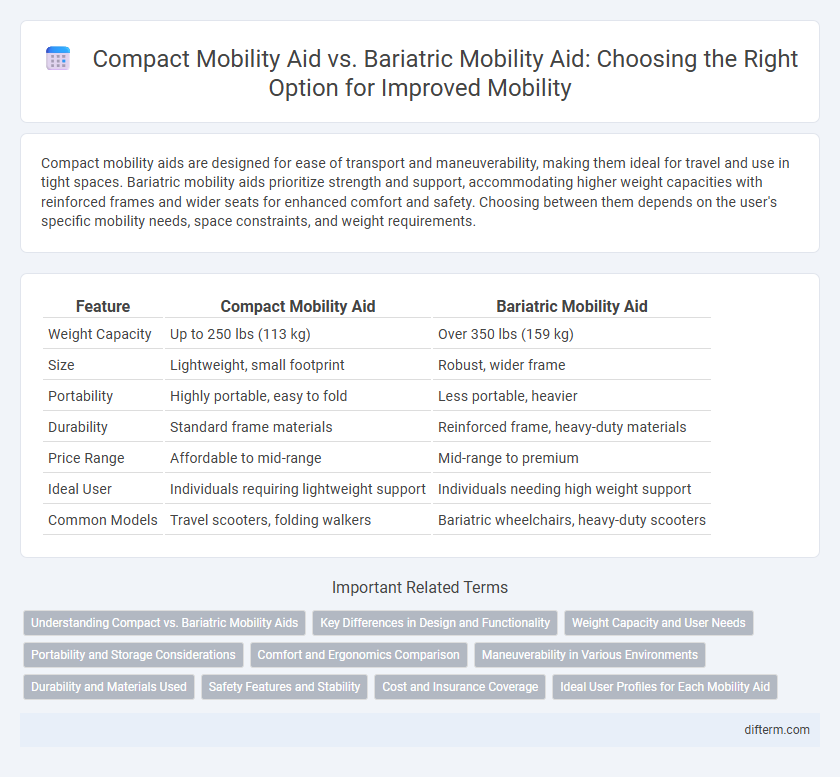Compact mobility aids are designed for ease of transport and maneuverability, making them ideal for travel and use in tight spaces. Bariatric mobility aids prioritize strength and support, accommodating higher weight capacities with reinforced frames and wider seats for enhanced comfort and safety. Choosing between them depends on the user's specific mobility needs, space constraints, and weight requirements.
Table of Comparison
| Feature | Compact Mobility Aid | Bariatric Mobility Aid |
|---|---|---|
| Weight Capacity | Up to 250 lbs (113 kg) | Over 350 lbs (159 kg) |
| Size | Lightweight, small footprint | Robust, wider frame |
| Portability | Highly portable, easy to fold | Less portable, heavier |
| Durability | Standard frame materials | Reinforced frame, heavy-duty materials |
| Price Range | Affordable to mid-range | Mid-range to premium |
| Ideal User | Individuals requiring lightweight support | Individuals needing high weight support |
| Common Models | Travel scooters, folding walkers | Bariatric wheelchairs, heavy-duty scooters |
Understanding Compact vs. Bariatric Mobility Aids
Compact mobility aids offer lightweight and portable solutions designed for users requiring minimal support, featuring foldable frames and smaller wheels for enhanced maneuverability. Bariatric mobility aids are engineered to support higher weight capacities, typically exceeding 300 pounds, with reinforced frames, wider seats, and durable materials to ensure safety and comfort. Choosing between these aids depends on individual weight requirements, ease of transport, and the level of stability needed for daily activities.
Key Differences in Design and Functionality
Compact mobility aids are designed for lightweight portability and ease of use in tight spaces, featuring smaller frames and reduced weight to enhance maneuverability. Bariatric mobility aids focus on durability and support for higher weight capacities, incorporating reinforced frames and wider seats to ensure safety and comfort for users with larger body sizes. The design differences primarily impact functionality: compact aids prioritize convenience and transportability, while bariatric models emphasize stability and strength.
Weight Capacity and User Needs
Compact mobility aids typically support weight capacities up to 250 pounds, making them ideal for users with standard weight requirements seeking lightweight and easy-to-maneuver devices. Bariatric mobility aids accommodate weights exceeding 350 pounds, offering reinforced frames and wider seats to ensure safety and comfort for heavier users. Choosing between these aids depends on individual weight capacity needs and the necessity for enhanced durability and support.
Portability and Storage Considerations
Compact mobility aids, such as foldable walkers and lightweight wheelchairs, excel in portability due to their smaller size and easy fold mechanisms, making them ideal for users with limited storage space or frequent travel needs. Bariatric mobility aids, designed to support higher weight capacities, tend to be bulkier and heavier, posing challenges for portability and requiring larger storage areas. When selecting a mobility aid, it is essential to balance weight support requirements with the convenience of storage and transport.
Comfort and Ergonomics Comparison
Compact mobility aids prioritize lightweight design and maneuverability, offering enhanced comfort through streamlined ergonomics ideal for everyday use and tight spaces. Bariatric mobility aids feature reinforced structures and wider seating to support higher weight capacities, focusing on durability and pressure distribution for improved comfort during extended use. Both types incorporate adjustable support elements, but bariatric models emphasize extra cushioning and stability to accommodate diverse body types and reduce strain.
Maneuverability in Various Environments
Compact mobility aids offer superior maneuverability in tight spaces such as narrow hallways, crowded stores, and small apartments due to their lightweight design and smaller turning radius. Bariatric mobility aids, while providing enhanced support and weight capacity, often have larger frames that can limit agility and ease of navigation in confined or crowded environments. Choosing the appropriate mobility aid depends on balancing the need for maneuverability with weight support requirements in diverse settings.
Durability and Materials Used
Compact mobility aids are typically constructed with lightweight aluminum or steel frames, prioritizing portability and ease of use, which may limit their durability under heavy or prolonged use. Bariatric mobility aids, designed to support higher weight capacities, use reinforced steel and heavy-duty components, offering enhanced durability and stability for users needing robust support. The choice of materials directly impacts the longevity and reliability of each aid, with bariatric options engineered to withstand greater stress and strain over time.
Safety Features and Stability
Compact mobility aids prioritize lightweight construction and maneuverability, incorporating anti-tip wheels and ergonomic handles for enhanced user safety. Bariatric mobility aids feature reinforced frames, wider bases, and heavy-duty brakes to support higher weight capacities and provide superior stability. Both types integrate non-slip surfaces and adjustable components to accommodate diverse mobility needs while ensuring maximum protection against falls.
Cost and Insurance Coverage
Compact mobility aids generally have lower upfront costs and are more likely to be covered by standard insurance plans due to their common specifications and lighter weight capacity. Bariatric mobility aids, designed for higher weight capacities, often come with significantly higher prices, and insurance coverage may require additional documentation or proof of medical necessity. Patients should verify their insurance policies and consider long-term durability and maintenance expenses when choosing between compact and bariatric mobility aids.
Ideal User Profiles for Each Mobility Aid
Compact mobility aids are ideal for individuals with mild to moderate mobility challenges who require lightweight, easily maneuverable devices for indoor and short-distance outdoor use, such as elderly users or those recovering from minor surgeries. Bariatric mobility aids are designed to support higher weight capacities and provide enhanced durability and stability, catering primarily to users with obesity or severe mobility impairments requiring robust, heavy-duty assistance. Selecting the appropriate mobility aid depends on user weight, mobility level, and daily activity demands for optimal safety and comfort.
Compact mobility aid vs Bariatric mobility aid Infographic

 difterm.com
difterm.com